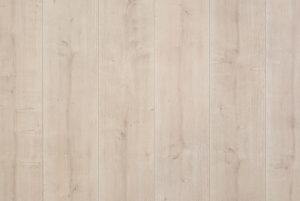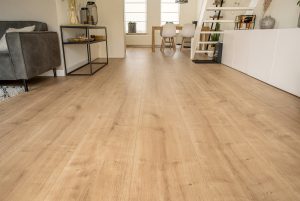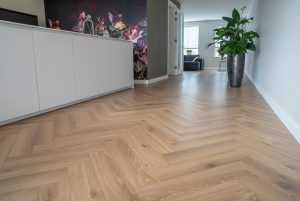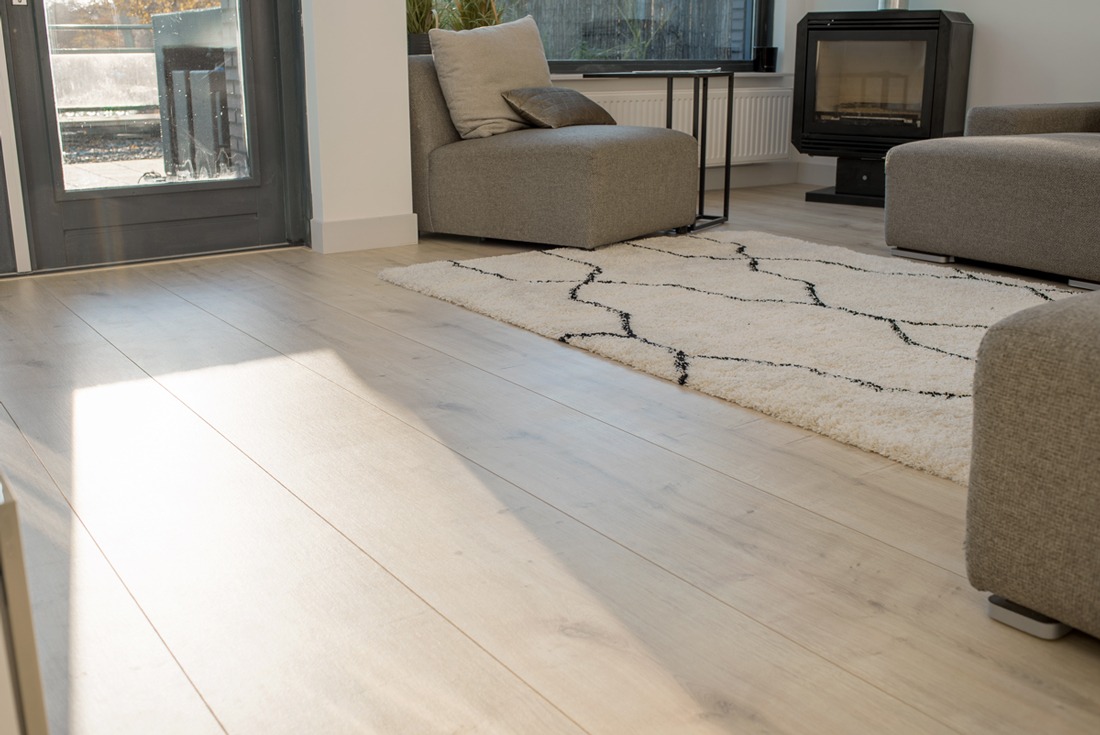Every type of flooring has a specific construction, and laminate floor is no different! You have probably heard or read that laminate floor is made up of several layers. Are you curious about the construction of your favorite laminate floor or do you want to know what it is? Floer to the rescue! In this blog you can read all about it and find out more about the structure of a laminate floor.
What is laminate?
Laminate flooring was invented in the 1970s as an alternative to oak parquet. A couple of decades later, a click system was added and laminate became known as the do-it-yourself floor. This was because the click connection made it much easier to install than oak parquet. Fast forward a few decades and we have today’s laminate flooring, with its convenient click joint and luxurious V-groove. With herringbone laminate, there is even a laminate alternative to the popular herringbone oak parquet . Combine this with the low maintenance nature of the floors, and you have a product that has become an integral part of living rooms around the world.

Floer with click connection?
As well as laminate, you can also opt for Click Vinyl if you want a floor with a click connection. It sometimes happens that a Vinyl floor is mistaken for a laminate floor. This is because the floors in the Herringbone Click Vinyl collection are very strong herringbone floors with a click system similar to a wide laminate floor, for example. This click system creates the idea that a Vinyl floor is the same as a laminate floor, hence the term Vinyl laminate flooring. So remember, these are two different products with different characteristics! Still not sure whether to choose a laminate floor or a click vinyl floor? Order your free Floer Catalogue and take your time to choose your favourite!
The structure of a laminate floor
What does the structure of a laminate floor consist of?
- The top layer of a laminate floor
- Decor layer
- HDF support board
- Underlay
1. The top layer of a laminate floor

The transparent top layer of a laminate board contains a layer of melamine resin. This layer gives the top layer of the board its wear resistance and makes it waterproof. The top layer therefore plays an important role in determining the performance class of the laminate flooring. Melamine also adds strength to laminate flooring and contributes to the stability of the plank. In the top layer of the laminate, a lifelike wood texture is incorporated, which makes Floer laminate flooring indistinguishable from oak flooring. This lifelike structure is known as ‘Register Embossing’, which creates a realistic design in the plank’s decor layer.
Several floors feature realistic ‘Register Embossing’. As with laminate flooring, a number of wide vinyl floors in the Country House flooring collection feature this texture. So do you want a realistic wood design? You don’t have to go for an oak or laminate floor; vinyl floors are also an option. Plenty of choice!
2. Decor layer
Underneath the top layer of the laminate floor is a layer we call the decorative layer. Why is this layer called the decorative layer? Basically because this layer is only used to enhance the look of the board. This layer is nothing more than a photo of a particular design that is then printed onto the board. A photo? Yes, so in practice you could have a laminate floor with a photo of your dog or cat on it. The downside is that the laminate is made in very small quantities and there are probably not many people waiting for a picture of your dog or cat.
The ability to create many different designs is the great advantage of these prints. For example, Reclaimed Wood Laminate can have a unique vintage & retro look. In addition, the designs are precisely tailor-made for each laminate floor. This makes a design such as herringbone laminate flooring stand out beautifully.
3. HDF support board
The support board, also known as the ‘core’ of the board, is the part that plays the biggest role in providing strength. This is because this component is an HDF board, which is made up of a large amount of compressed wood fibers. HDF stands for ‘High Density Fibreboard’ and its density is between 700 and 800 kg per cubic meter, which guarantees a very strong core board. If you were to choose an MDF core, there would be fewer wood fibers present and you would automatically get a less strong core board. This is why Floer laminate flooring has an HDF core.

4. Underlay
Like the top layer, the bottom layer of a laminate board contains melamine resin. This part of the board protects the core and also provides some insulation. The bottom layer also ensures that the HDF board does not come into contact with your sub-floor, so that it is not damaged. Want to know what kind of underlay you need for your laminate floor? Choosing the right underlay is very important for maintaining the quality of the floor. So get some good advice!
Prefer a Vinyl floor?
Would you like a Dryback Vinyl floor without the click connection? Herringbone Vinyl has an embossed wood pattern and is as safe as a child’s toy! Want to know more about 100% clean vinyl flooring? Discover the labels at Floer! Do you prefer a herringbone Vinyl floor but would like a slightly larger plank? In the Whalebone Vinyl floor collection you’ll find extra wide XL herringbone vinyl floors in a natural oak design. Want to see how a Floer floor would look in your home? Order a sample and find out! This way you can immediately see if the vinyl tiles you have in mind will suit your interior, take a closer look at the construction of laminate and experience the concrete look of click vinyl tiles. Or visit your local Floer dealer !






